Word Processors:
7 For The 8-Bit
Finally, a real choice
By Gregg Pearlman, Antic Junior Editor
Atari 8-bit computers are fine word processing tools. For $500 or less--the price of a computer, printer, disk drive, software and some paper--you can have clean, correction-free documents that make ordinary typewritten material look as if the cat did it. In terms of versatility speed, ease of use and readability word processing is as far above typewriting as typewriting is above penmanship.
An individual word processor is an acquired taste. Features that please some might annoy others. Even the five Antic editors are split on their favorites. For personal use, two prefer PaperClip, two use AtariWriter or AtariWriter Plus, and the fifth uses Letter Perfect.
What follows is a detailed comparison--including a features chart--of seven word processors currently available for Atari 8-bit computers. These word processors are AtariWriter Plus, First XLEnt Word Processor PaperClip, Letter Perfect, Superscript, Word Magic and HomeText.
80 COLUMNS
The biggest lack in 8-bit Atari word processing to date has been the unavailability of an 80-column screen display that shows your page exactly as it will print out. However, Atari now says that its long-awaited XEP80 80-column adapter box will be shipping in January, 1987.
The XEP80's razor-sharp text display was demonstrated at last year's trade shows and Atari Fairs. The $79.95 adapter plugs into either joystick port and includes its own parallel printer interface. It works with either monochrome or color monitors. Prompt release of new versions supporting 80 columns on the XEP80 are expected from AtariWriter Plus, PaperClip and First XLEnt Word Processor. ACE80 ($49.95. Reviewed in Antic, July 1986) and Write80 ($59.95. Reviewed in October 1986) each offer 80-column displays without the XEP80 hardware. But neither of these products can be considered full-featured word processors like the other software in this report.
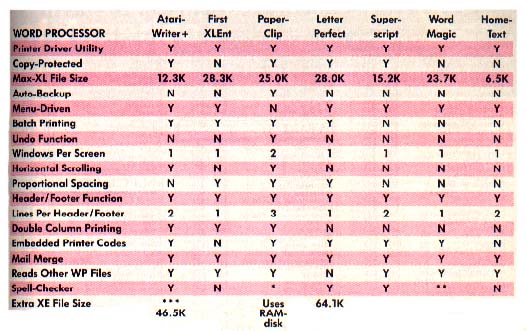
ATARWRITER PLUS
AtariWriter Plus does many things well. Its Proofreader and Mail Merge functions make it one of the most complete word processing packages available for Atari 8-bit computers. AtariWriter Plus is powerful and versatile, it does not drop characters or lock up as you type, and it has a 36,000-word spell-checking dictionary.
The main limitation we found is a maximum file size of only 12.3K on the 800XL, slightly less than half of the file sizes we ohtained from four other word processors. (See features chart.)
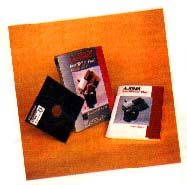
However on the 130XE (and compatible memory upgrades) there are 15,872 bytes free--in each of three "banks." Files longer than 15.5K "spill over" into the next available bank. [START] [R] switches from one bank to another, and [OPTION] [F] evenly distributes the file among all three banks.
AtariWriter Plus can be configured to almost any printer. You need to load the printer driver every time time you boot up. The print preview feature gives you horizontal scrolling in more than 200 columns, and underlined characters appear in inverse video. However, boldface, italics and othor special fonts are not indicated onscreen. The AtariWriter Plus Mail Merge lets you create an electronic mailing list with up to 255 records per file.
AtariWriter Plus's powerful search-and-replace lets you use question marks as "wild card" characters. And global substitution is almost instantaneous--you don't have to watch the cursor scroll through the entire file.
The Proofreader program takes a little while to load, but it quickly scans your file for anything unusual, at which time an obnoxious beep alerts you. [CONTROL] [B] from the main menu deactivates the alarm. You can correct the word, search the dictionary or keep that spelling. You can also create personal dictionaries of up to 8,400 bytes. (For example, 8,400 bytes would hold 1,200 words consisting of six letters and a space.)
While the Antic editorial staff has had no problems with AtariWriter Plus, this isn't entirely true of our readers. We have received a trickle of letters listing minor complaints. For example, apparently headers and footers are sometimes printed somewhere other than where you want them.
$49.95. Atari Corp., 1196 Borregas Avenue, Sunnyvale, CA 94086. (408) 745-2000. (Reviewed in Antic, April 1986, page 81.)
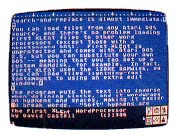
FIRST XLENT
First XLEnt Word Processor is the newest 8-bit product in this category and it is packed with unique and impressive features. First XLEnt lets you add pictures to the text, use the joystick for cursor movement, edit two documents at once, load in any Atari 8x8 font (such as international character sets). Help screens are easily available and search-and-replace is almost immediate.
You can load files from any DOS (including specialized operating systems such as SpartaDOS). And there's no problem loading First XLEnt files to other word processors that use an Atari-compatible DOS. First XLEnt is not copy-protected and comes with Atari DOS 2.5, but you can substitute your own DOS--meaning that you can set up a large RAMdisk, for example. In fact, First XLEnt uses the 130XE RAMdisk, so you can load files lightning-fast-tantamount to using an extra edit window.
The program wordwraps on spaces and hyphens, making word-breaks cleaner. "Soft" hyphens are ignored unless needed for a line break, and "hard" spaces prevent a line break at that space. However if you use a double hyphen for dashes (-), they will be split up at the end of a line when printed.
First XLEnt has a visible, editable cut-and-paste buffer. You can insert a disk file anywhere in your text without losing the end of your document. You can save to disk any part of the document in memory. Also, when working with two documents in memory, First XLEnt flips between them instead of splitting the screen into small windows. (Those who prefer two windows might like PaperClip better.)
The biggest limitation we found in First XLEnt is that the cut-and-paste buffer holds you to one screen--800 characters. Also, the printing section in the manual could be more informative.
When you go to the icon menu you're not always returned to your original spot in the text, or even to the same typing mode. If you were in Insert mode, you might find that you've overwritten some of your document before you realize you're no longer in that mode. And finally, the [CONTROL] key combinations on the 800 become [OPTION] key on the XL/XE.
But despite any minor quibbles, the First XLEnt Word Processor is a most welcome entry in the 8-bit market. It's powerful, easy to use and highly original.
$29.95. XLEnt Software, P.O. Box 5228, Springfield, VA 22150. (703) 6114-8881. (Reviewed in Antic, January 1987, page 53.)
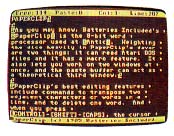
PAPERCLIP
As we've said on various occasions. Batteries Included's PaperClip is the 8-bit word processor we use at Antic. Several features weight the dice heavily in PaperClip's favor. It has "macro" capability for writing out lengthy strings of stored text with just two keystrokes. It has a generally fast and efficient command structure. It lets you work on two windows at once, and can use the paste buffer as a third window. It reads standard Atari DOS files, so you can easily work with files from most other 8-bit word processors.
PaperClip's best and most original editing features include commands to transpose two adjacent characters or words in a line, and to delete one word. When you press [CONTROL] [SHIFT] [CAPS], the cursor scoots along, changing capital letters to lowercase or vice versa. The search-and-replace feature is good, but it slows down as file size increases.
However, you can search and replace as many as six strings during a single global substitute. You can easily merge files, rename or erase them, and format disks. PaperClip can automatically save your text after a number of keystrokes which you select.
PaperClip's commands are generally easy to remember [CONTROL] [SHIFT] [R] Reads a file from disk, and [CONTROL] [SHIFT] [W] Writes it to the disk. [CONTROL] [SHIFT] [M] Moves a block, [CONTROL] [B] turns on Boldface, etc. But then [CONTROL] [A] sets print tabs and [CONTROL] [T] forces a new page, so the memory associations are not always that clear.
Among the word processors in this report, only Superscript and PaperClip have math functions. PaperClip can add, subtract, multiply and divide, and print totals and subtotals. But you need to use the print preview window to see the results, which for unknown reasons often renders useless the block move command, [CONTROL] [SHIFT] [M].
Other functions include batch file processing and Mail Merge. The utility files also include machine language printer driver maker, a graphics dump and an AtariWriter to PaperClip conversion program. [CONTROL] [SHIFT] [1] gives a word count, but it's not terribly accurate. It counts spaces, not words, and consequently misses by as much as 20 percent. The print preview feature uses PaperClip's wide horizontal scrolling to display the page as it will look on paper.
Despite all these flashy and valuable features, Antic editors have learned from nearly two years of heavy PaperClip use that the software sometimes mysteriously locks up or drops characters. Also, the type-ahead buffer is often too slow to keep up with reasonably speedy typing, especially at line-breaks.
The program doesn't tell you when your data disk is full. And in a rare copy-protection scheme, you can hack up the disk but you must plug the enclosed "hardware key" into joystick port 2 to run PaperClip. That key costs $20 to replace, but a keyless 48K-only version is available for $39.95.
Our copy of SpellPack, the spellchecker in PaperClip's 130XE version, didn't show words like "without," "us" and "too." But it had no problem with "mnemonic" or "dubious" and it also provided a large selection of non-words such as "usabg" and "thesficking."
However, Batteries Included has assured Antic that these bugs are fixed in PaperClip version 2.0 which is presently shipping. Upgrades are free with a dated receipt within 90 days of purchase. After that, the fee is $10 for an updated 130XE version and $15 for an upgrade from XL to XE.
$59.95. Batteries Included, 30 Mural Street, Richmond Hill, Ontario, L4B 1B5, Canada. (416) 881-9941. (Reviewed in Antic, May 1985, page 24.)
LETTER PERFECT
LJK's Letter Perfect has been around for Atari 8-bit computers since 1981. It uses its own operating system and cannot use files compatible with Atari DOS unless they are converted with LJK's Utility Disk. This translator can switch files back and forth between Letter Perfect and standard Atari DOS formats.
You also need another translator disk (such as FIX-XL from The Catalag) to run Letter Perfect on an Atari XL or XE.
We used Letter Perfect as our Antic word processor until PaperClip came along. One of the things we liked about it was that it could be used with the OmniView 80-column card. ($69. CDY Consulting, 421 Hanbee, Richardson, TX 75080. (214) 235-2146.)
Getting to most of Letter Perfect's file commands requires you to press the [ESC] key, which takes you from the editing screen to a main menu. It takes a while to learn Letter Perfect commands. But once you do, you should have little trouble. Almost refreshingly, you can type as fast as you want and each character will appear on the screen almost instantly.
Letter Perfect has an outstanding spell-checker. This, however, necessitates using yet another disk. But when you see how quickly the program counts words in a document and searches the dictionary disk, you won't mind.
Letter Perfect's non-standard operating system is its biggest drawback. If you normally work with Atari DOS files, it's inconvenient to use a word processor that doesn't. And what happens if you find a word processor you like better? You must convert all your active files with the LJK Utility Disk.
$99.95. UK Enterprises, 7852 Big Bend Blvd., St. Louis, MO 63119. (314) 962-1855. (Reviewed in Antic, March 1985, page 38.)
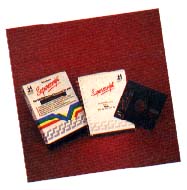
SUPERSCRIPT
With the British-designed Superscript, beginners can select commands from a menu structure, while experienced users can work faster with single-key [CONTROL] commands.
Superscript and PaperClip are the only 8-bit Atari word processors that offer macros and arithmetic functions. The macros let you type out an assigned string of characters by pressing one key. Superscript's math processing is outstanding. You can calculate in columns, rows or tables within the text. In fact, you can automate the arithmetic with macros to create a mini-spreadsheet-especially since text width can be scrolled up te 24O columns across.
Print formats are very flexible and easy to customize. You call even print every other page, if you want to feed your paper through twice and produce a document that is printed on both sides of the page. And you can print alternating wide margins to allow binding.
Superscript comes with an expandable dictionary which the distributors say contains 20,000-words. Actually, you get to choose between two dictionaries, offering either British or American spelling. You add your own personal words to the main dictionary simply by typing them in and pressing a single key.
The program loads text only by line units, so you can run out of file space after 780 carriage returns. Fortunately, the disk storage scheme is more efficient.
Superscript requires an Atari XL with at least 64K, or a 130XE. On the 130XE, the program lets you load two files into memory and flip back and forth between them. Just as in First XLEnt, you can move text between the dual files even though the windows are not onscreen at the same time.
Especially if you use a lot of arithmetic in your text files, Superscript should be seriously considered as your word processing choice.
$59.95. Progressive Peripherals and Software, 464 Kalamath Street, Denver, CO 80204. (303) 825-4144. (Reviewed in Antic, March 1986, page 13.)
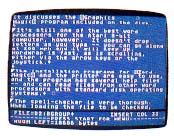
WORD MAGIC
Word Magic from The Catalog is one of the best all-around word processors for the Atari 8-bit computer. It doesn't drop letters as you type--you can go along at 200 mph and it will keep up. Wordwrap is fast, as is scrolling, either via the arrow keys or the joystick.
The installation programs for Word Magic and the printer are easy to use. The program has several help files, and it can read files from other word processors that use standard disk operating systems. As with most products from The Catalog, the Word Magic documentation is on the back of the program disk.
Like PaperClip, Word Magic occasionally locks up, we found. So it pays to save your file often. Also, Word Magic stores a line with only a single carriage return as 40 bytes. It treats the 39 screen spaces after the return as bytes in the file, even though they're useless. Word Magic loads the printer driver from disk each time it prints. This is a comparatively slow process.
One of the best features of this word processor is its spell-checker. Spell Magic ($19.95. The Catalog, AP0144.) isn't literally part of Word Magic, but the programs definitely work hand-in-hand. And Word Magic can be copied to a disk containing Spell Magic, which makes things easier and faster.
The spell-checker is very thorough--although it takes some time to load the 34,000-word dictionary. When you load the file to be checked, the program counts the total words and unique words, prompts you to insert your personal add-on dictionary, if any and then to insert the Spell Magic Dictionary. Spell Magic slowly scans the disk, which takes over 10 minutes. But then it very quickly checks through your document. Spell Magic also works with any other word processor that uses standard Atari DOS.
$19.95. The Catalog, AP130. $29.95 for 130XE version including Spell Magic, AP0160.
HOMEPAK HOMETEXT
Batteries Included's HomePak is best known for HomeTerm, an excellent telecommunications program. It also includes HomText, a good introductory word processor and HomeFind, a good introductory file manager. All three programs can easily share data files.
HomeText's maximum file size is only 6,620 bytes (1,000 to 1,500 words), which makes it suitable primarily for writing personal letters or short memos. It has very few editing commands, and its printing and storage commands can be accessed only by leaving the text window. Its stylized character set is somewhat distracting.
But HomText has an outstanding block-move function that leaves most of the others in the dust. Block move, delete and copy occur almost instantly--but of course the small file size maximum is a factor here.
HomText is easy to use. If the command letter doesn't start the command word, at least it's in the command word and is highlighted--as in EXIT to Menu.
For some reason, HomeText's command symbols are more than one character long. In HomeText, the paragraph symbol is "Indnt (right arrow)5." Highlighting a single letter in a word, as in EXIT above, makes it hard to read.
$19.95. Batteries Included, 30 Mural Street, Richmond Hill, Ontario, L4B 1B5, Canada. (414) 881-9941. (Reviewed in Antic, March 1985, page 74.)